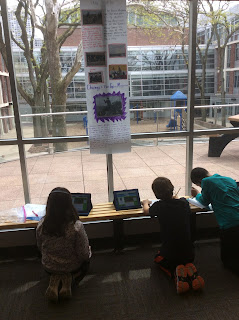At the end of the school year third grade students study the city of Chicago, its history, neighborhoods and immigrants and people. Students spend time learning about the different immigrants that moved to Chicago, the Great Fire and architecture of the city. To end the school year we also wanted to do an extension project in the library project time that connected to this central topic. Third grade had not been introduced to Tinkercad 3D design software and the 3D printers. I decided to combine these areas for our last collaborative project of the school year.
To start the project students focused on the three neighborhoods that they talk about during their immigration study, Bronzeville, Pilsen and Chinatown. Bronzeville is a traditionally African-American neighborhood that was settled during the Great Migration. Pilsen has been a neighborhood of immigrant working population for over 140 years, the last 40 years it has mainly been home to Mexican immigrants. Chinatown was founded in the early 1900’s for the thousands of Chinese Americans that migrated to Chicago from California with the building of the transcontinental railroad. In each of the deeper studies of these neighborhoods we focused on different aspects of the neighborhoods that highlighted the cultures and histories of these distinct areas.
Our first neighborhood of focus was Bronzeville. The focus of this study was looking at the Great Migration and individuals that it brought to the neighborhood. Students learned that the Great Migration was a movement of more than six million African-Americans from the racist south to the North where there were more jobs and opportunities. They still faced prejudice and discrimination but it was not as overt as the Jim Crow laws of the south. Students then looked at images from Jacob Lawrence’s painting series about the Great Migration. Next students learned more about African-Americans who moved to the Bronzeville neighborhood during this period of time. They learned about Bessie Coleman, Louis Armstrong, Gwendolyn Brooks, and Ida B. Wells. Students read articles about these individuals and looked at archived images of the people and connections to some of the places in Bronzeville.
The next neighborhood we looked at was Pilsen. The Pilsen neighborhood has been a haven for working class immigrants for more than 150 years. The neighborhood started out with Irish and German immigrants working in the stockyard and railways of Chicago. Then came the Eastern European immigrants, Czech immigrants gave it the name Pilsen. For the last forty years the neighborhood has been home to Mexican immigrants. Over the last several decades community leaders have commissioned artist to create murals in the Pilsen neighborhood that reflect the issues that are important to the people of the neighborhood. Students spent some time looking at the murals and learning more about the meaning behind the paintings. Many of the murals deal with the challenges facing undocumented immigrants in the United States. Students read an article that talked about the challenges facing this community and what that means for the Pilsen community.
The final neighborhood that we looked at was Chinatown. Students learned about the history behind the area. Third graders learned that many Chinese immigrated to the United States in the 1850-60’s coming to California. Many made their way East working on the transcontinental railroad. In the 1870’s there was an economic crisis and the United States government passed a law called the Chinese Exclusion Act that prevented immigration from China. The goal of this act was a racist law that wanted to prevent Chinese from coming to the United States and keeping the available jobs for white Americans or European immigrants. An additional effect of this law was that Chinese Americans living in California were the victims of hate crimes and horrible treatment. Many Chinese left California to move East in the hopes of finding a friendlier area. Chicago was a more welcoming environment for the Chinese but not a perfect one, they still experienced prejudice and racism here as well. Third graders learned that in 1902, leaders in the Chinese community in Chicago started to lease and acquire land in the neighborhood that is now Chinatown. The community leaders wanted the neighborhood to be a place that was welcoming to Chinese Americans and Chinese immigrants. They also wanted the area to reflect important elements of Chinese architecture, design and culture.
In each of these dives into the neighborhood students listened to articles or music, read background information about people, places or major events, and spent time looking at paintings and current and historic photographs. Students used many of our digital research resources for this study. Third graders followed the see/think/wonder thinking routines at each of these stations to keep take note of what they saw in the images and photographs, facts and information they connected with and what they were still wondering about. This thinking routine would help them as they went on a trolley tour of the neighborhoods they learned about and connected the information they were learning in their classroom curriculum about immigration and Chicago.
Next step: Neighborhood inspirations & 3D design









No comments:
Post a Comment
Note: Only a member of this blog may post a comment.